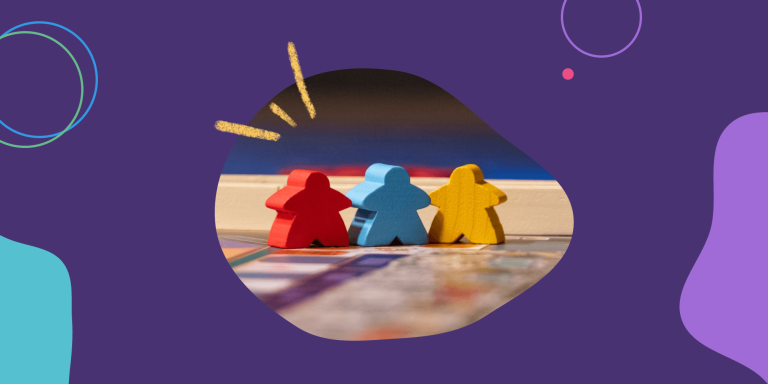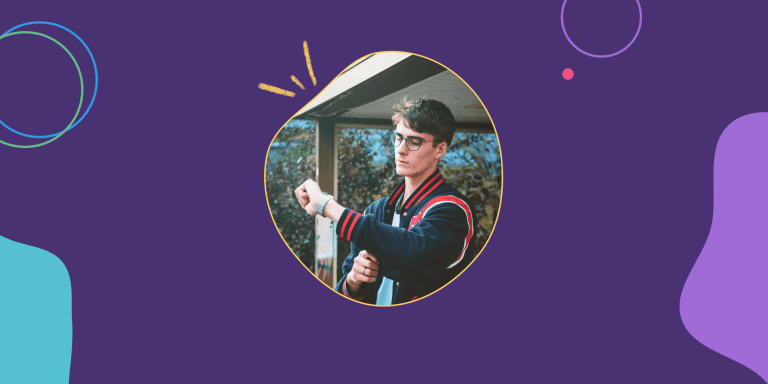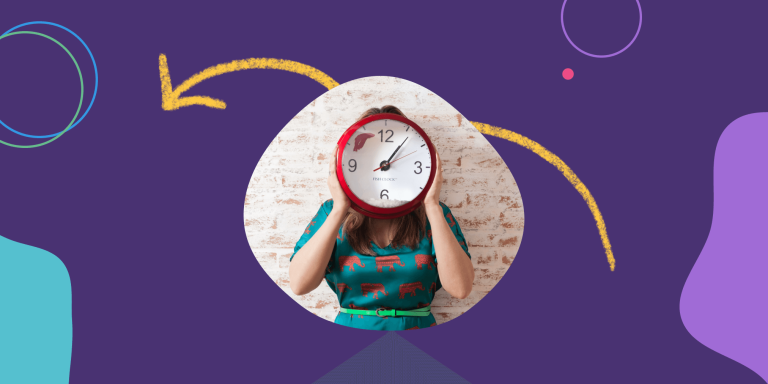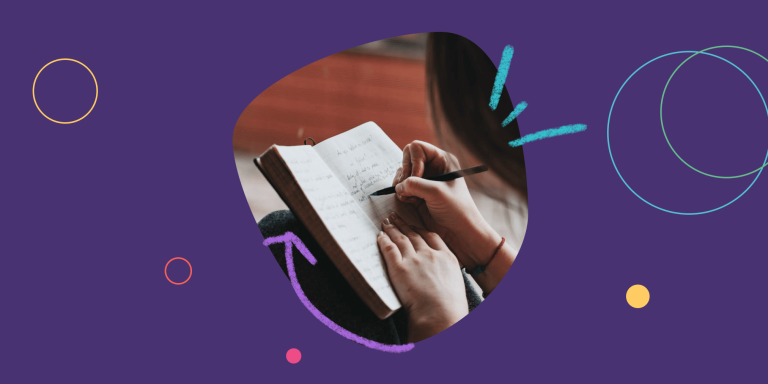Fresh Retrospective Ideas for New Agile Teams
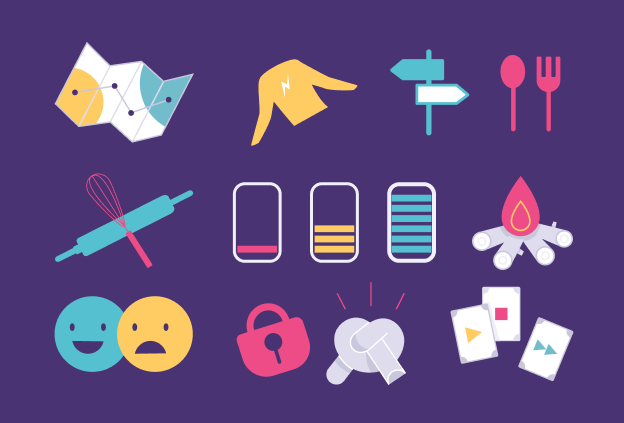
Running your first retrospective with a new agile team can be daunting.
It takes time for team members to feel comfortable being honest and open around each other. Also, your new team probably hasn’t worked together much, so there might not be much to reflect on. And without much to reflect on, you’re essentially growing a plant in a desert, missing the rich soil you need to feed your new practice.
Starting a retrospective habit with a new agile team helps build continuous improvement right from the start. But before that can happen, the team lead needs to consider what role retrospectives fill for their team, and then pick a format that encourages the right kind of conversation.
For experienced agile practitioners who know each other well, a retrospective is an opportunity to define how the team will work together.
For a team of folks entirely new to agile and shaken up by whatever change led to the team existing in the first place, a retrospective can help get some of the challenges and feelings out on the table and set the team up for success.
Whatever the particular situation with your new agile team, we’ll look at what your team needs from their first retrospective, and suggest a retrospective format geared towards supporting you.
Here are 7 retrospective formats to try with your new agile team, depending on what you’re dealing with:
- Hiking Retrospective for New Teams Dealing with Chaotic Change
- Dream Team Retrospective for Agile Teams Finding Their Rhythm
- Energy Levels Retrospective for Teams Getting to Know Each Other
- Hopes and Fears Retrospective for New Agile Teams That Need an Honest Conversation
- Escape Room Retrospective For Teams with Strong Opinions
- Superhero Retrospective For Teams Looking to Build or Refresh Team Dynamics
- Baking Danish Retrospective For Experienced Agile Teams Who Want to Have Fun
Let’s dive into what new agile teams need from a retrospective, before looking at seven formats lovingly crafted to help team leads in their first retrospective with a new agile team.
What New Agile Teams Need: Trust, Practices and Processing
New agile teams face a variety of challenges when they set out on their journey together.
Some of these challenges are:
- Team members may not know each other well, and may not have a rapport with one another. This is a challenge because strong-performing agile teams are built on trust. Team members need to be able to trust one another to fulfil their various roles in the development process and speak up on issues so the team can continuously improve.
- New agile teams often haven’t defined the practices that guide their agile development cycle. Unlike waterfall development, which depends on a perfect design and a strictly planned roadmap created ahead of time, agile development is built on a set of practices that create fast iteration cycles. For new teams, these practices aren’t yet second nature, so delivery is often slower. To get to the performing stage, new teams need to get into their habits quickly.
- Team members need time to build trust. When a new team forms, it’s often a chaotic time. Whether the new team came about because of a problem or an opportunity, team members will probably feel uncertain in their new role. To get to team members comfortable, teams need to voice and process their perspectives on the change that’s happened. Retrospective meetings provide an opportunity to do just that, but since the team doesn’t have a lot of trust, it’s up to the team lead to find a format that gives the team the opportunity to have an honest conversation without putting anyone on the spot.
When trying to pick a retrospective template for a new team, ask yourself three questions:
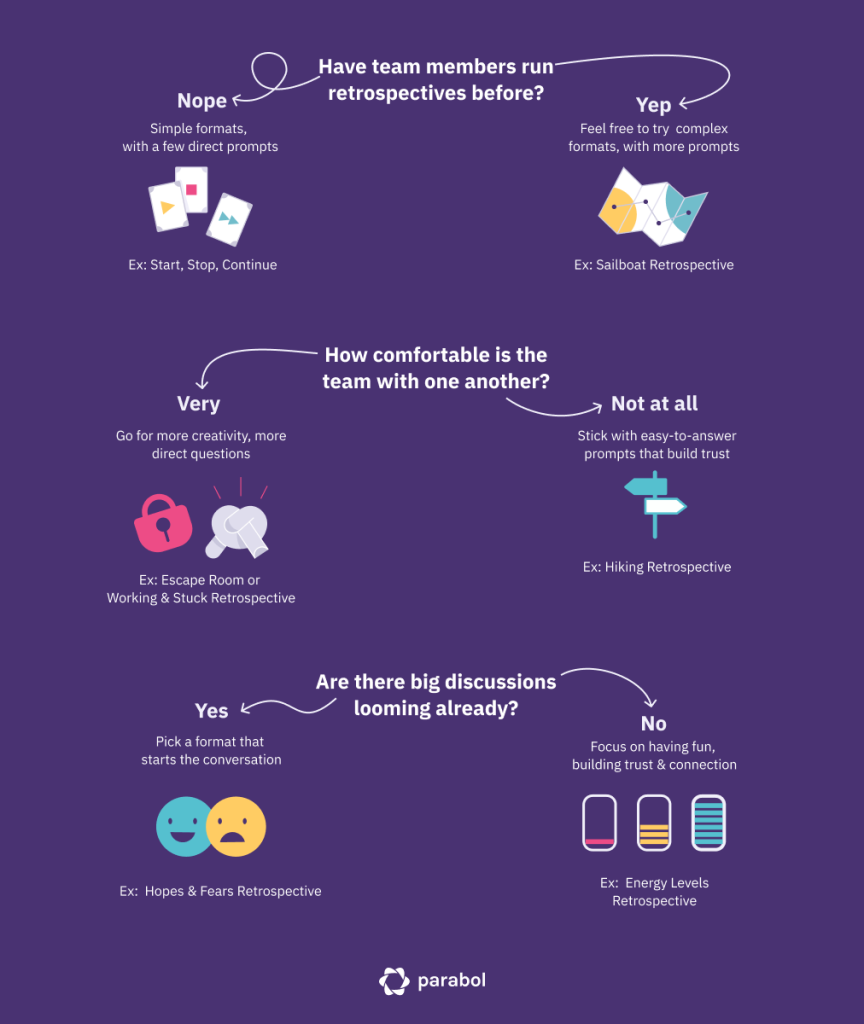
Question #1: Have team members run retrospectives before? Teams that are comfortable with the practice can handle more complex formats. Teams that are newer to agile in general will need an easier on-ramp.
Question #2: How comfortable is the team with one another? When folks know one another, they’ll feel comfortable talking. In this case, there’s less of a burden on the format or agenda to spark conversation, it’ll come naturally. More comfortable teams might also be ready for more creative templates.
Question #3: Are there big discussions looming already? New teams may be formed due to internal re-organization, new ventures, or new internal projects. If you know some team members are feeling stressed or overwhelmed in the new team, give them the gift of an anonymous space where they can voice that. Just putting that out there in the team is the first step towards building empathy and processing issues.
#1. Hiking Retrospective
For New Teams Struggling with Change

New teams dealing with change might be feeling a lot of uncertainty. Team members may struggle to understand their new role. They may also have left behind their peers on previous teams or their team lead – folks they relied on to soothe that stress.
The Hiking Retrospective helps you support your team by giving them a safe space to discuss what’s going on and helping them build trust with one another.
Here’s what it looks like:
- ⛅ Weather: How are you feeling? This explicit prompt lets team members share how they’re feeling anonymously. They can gain a sense that they’re not alone in their uncertainty, and also voice challenging feedback. Since they don’t know one another, they might not have the trust needed to otherwise voice these concerns.
I’m worried that our team might not have all the right skills to be successful
- 👝 Supplies: What do we have available? This prompt lets new team mates share what they can bring to the table, building some familiarity with each other. It also cues team members to look around and see tools and knowledge they have at their disposal, reminding them that even when faced with a difficult task, they’re equipped to tackle it.
If anyone needs a hand with Ruby on Rails, I have a pretty solid knowledge of that
- ⛳ Mile Markers: What are we looking forward to? Finally, this prompt focuses the team on the future, and away from the worries they’re feeling. By reminding them that there are exciting times on the horizon, you can lift the team out of a possible dark cloud.
I’m so excited about launching version 1.0 of the new app. It’s going to be so cool if we can get it right.
With this format, you can address and relieve the nervousness of the team while also giving them something to look forward to as motivation.
#2. Dream Team Retrospective
For Agile Teams Finding Their Rhythm
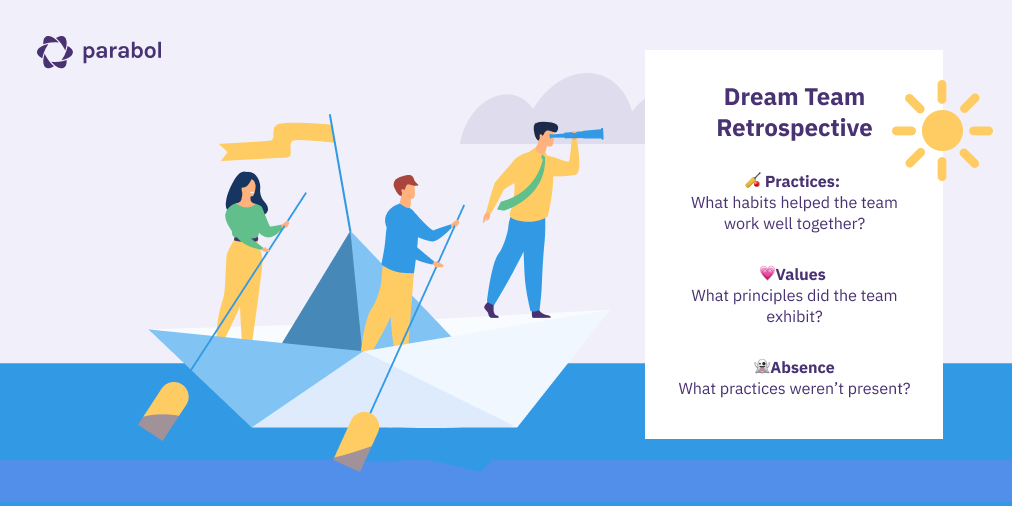
Teams that are new to agile but know each other pretty well should be focused on getting into an agile rhythm quickly – at least if there are no big changes coming their way.
Team members may need to be educated on the underpinnings of agile, and folks used to working in a different way with other teams may need encouragement to try something new.
To help your team find their agile rhythm, ask team members to think about a team that works really well. Ideally, this is a team they’ve been on, so they can speak really precisely to what led to that team’s success.
If they can’t think of one, they could imagine a hypothetical or fictional team.
Now work through the prompts of the Dream Team Retrospective:
- 🏏 Practices: What habits or processes helped the team work well together? Team members can share what habits they’ve seen work well, prompting a discussion about whether the team want to bring those habits into their new team.
We could make sure our daily standup is all about unblocking each other and try to stick to that. In my old team we moved away from reporting what we were doing towards unblocking each other. It was way more efficient.
- 💗 Values: What principles or values did the team exhibit? Encourage team members to think about what underpins how a great team works. Perhaps it’s all about sharing work early, putting direct feedback even over politeness or perhaps compassion even over direct feedback. High-performing teams can be built on all kinds of values, and your team needs to determine which ones matter to them. If the team agrees that certain principles matter, adopt them for yourselves. If not, you can discuss your different perspectives and get to know each other better.
Knowing what’s going on is really important to me. For example, I prefer when my team works in open channels, rather than DMs.
- 👻 Absence: What practices weren’t present? What makes a team perform well is often as much about the practices they’ve chosen as the one they’ve abstained from. The team may agree that politics, gossiping or insecurity should be avoided. Team members may share particular anecdotes about how this worked on other teams, prompting a discussion of how you can follow that path as well.
Work didn’t change ad-hoc – we picked what went into the sprint, assigned them, then focused on delivery for the length of the sprint. That allowed us to focus.
The Dream Team retrospective can help new teams get comfortable with the principles behind agile development practices and agree ways of moving forward together.
#3. Energy Levels Retrospective
A Template for Teams that are Getting to Know Each Other

For teams that are familiar with agile but don’t know one another, you probably want to help the team get to know one another and build rapport.
To support this goal, you can try an Energy Levels retrospective, which lets team members share what they love working on and what they’re less keen on. Since team members don’t know what other common ground they have, talking about their relationship to their work, preferences among different types of tasks and their knowledge and expertise helps team members get to know each other in a low-stress way.
The prompts for the Energy Levels retrospective format are:
- ✨ Fully Charged: What’s exciting for you to work on? Team members can share what energized them in their first few sprints with the team, or give examples of what they’d like to be working on. This helps team members learn what kind of work they all want to be doing.
Doing code reviews is weirdly relaxing for me – I’m happy to take more of that work on
- 😴 Low Energy: What drains you to work on? Team members can speak to practices or trends happening within the team that need improvement, or share the kind of work they don’t like. This gives the team the opportunity to change bad habits early and also gives team members the opportunity to offer help to one another – chances are, the work that’s draining one person would excite another.
Working with the API just isn’t my thing – it always takes longer than I think it will
- 💪 Sprint Energy: How do you feel about our current work? This prompt gives the new team an opportunity to reflect on how they’re feeling in these early days. While the team might not be dealing with a big challenge, scrum masters and team leads can gauge how the transition is going and adjust course.
I’m blazing through my tasks, but that new integration is really draining my energy. There’s a lot to learn to get it right.
The Energy Levels retrospective lets team members learn more about each other’s preferences and get to know each other. .
#4. Hopes and Fears Retrospective
A Template for New Agile Teams That Need an Honest Conversation
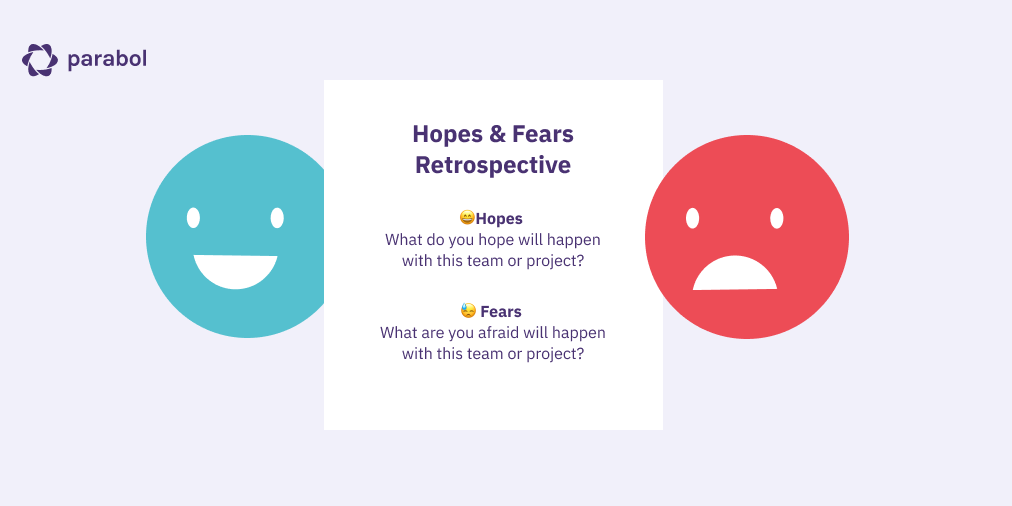
New teams are sometimes formed to address exciting new opportunities or tackle important problems. In those cases, the first task is to have an honest conversation about hopes and fears for the journey ahead.
If the team is familiar with one another and familiar with agile, they can probably handle an honest and direct conversation.
The Hopes and Fears retrospective helps teams have that honest conversation upfront, so you can talk about how to fulfill hopes and how to allay fears.
Here’s what it looks like:
- 😄 Hopes: What do you hope will happen with this team or project? First, the team can share their aspirations – what do they want to happen. By getting hopes out on the table, you can establish if everyone has the same goals for your shared work, and resolve or clarify any differences between these to establish a clear team charter.
I hope this new onboarding experience will help users who are struggling to get started with our product.
- 😓 Fears: What are you afraid will happen with this team or project? Next, the team can share their concerns – what they want to avoid. Like in a premortem, getting these worries out on the table lets you make plans to steer clear of them. Multiple people may voice the same worry, in which case they can feel a sense of camaraderie with one another and collective ownership for addressing that fear.
I’m scared that bugs coming in from support will sabotage our sprint work
The Hopes and Fears retrospective template lets experienced team members gathering together for a novel challenge have a direct conversation about the task at hand.
#5-#7 Fun Retrospectives that Remix Old Favorites
Sometimes, a new agile teams may be formed from experienced agile practitioners. Perhaps they’ve been working at the same company for a while and have some basic familiarity with one another, and they’ve been brought together to tackle something that everyone is confident they can handle.
In that case, the pressure is off for your first retrospective. Scrum masters can rest a bit easier, knowing the team is well-positioned for success.
You have an opportunity to bring something fun and new to team members that have already experienced the greatest hits of agile retrospective formats.
To do that, you can try remixing those old standbys with a new theme.
#5. Escape Room Retrospective
Working & Stuck for a team that loves puzzles
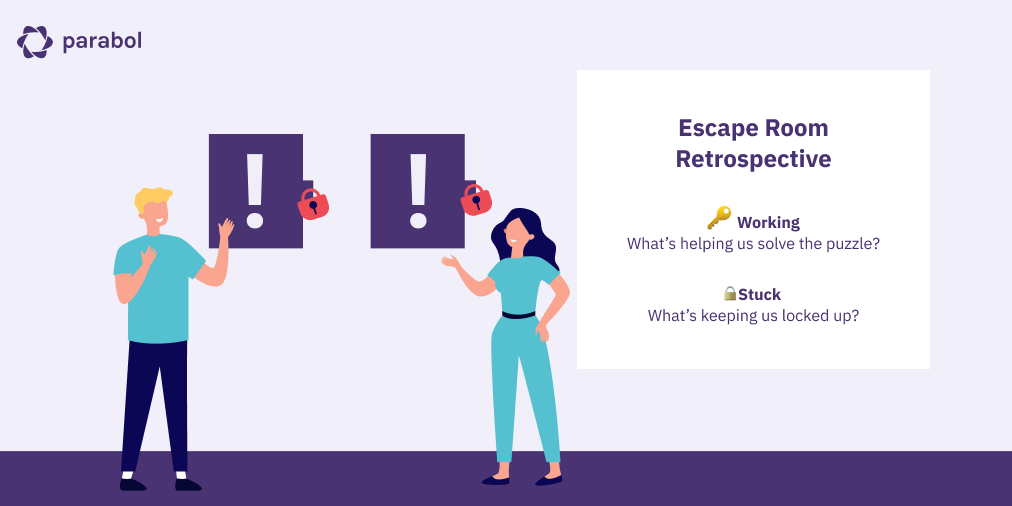
Experienced team members often have strong opinions about what’s good and what’s bad. You can benefit from all that knowledge while having fun by reframing a Working & Stuck retrospective with an escape room theme:
- 🔑 Working: What’s helping us solve the puzzle? Team members share their perspective on what they want to bring to the team that’s been successful elsewhere.
Testing as we develop will save us a lot of time later on and help us ship cleaner code
- 🔒 Stuck: What’s keeping us locked up? Team members can give examples of cultural norms, habits or beliefs that might hold the team or organization back.
In my experience at this company, we never implement data tracking early enough in development, so we end up flying blind. Let’s be more proactive.
The Escape Room Retrospective puts a puzzle-themed spin on the classic Working & Stuck format.
#6. Superhero Retrospective
For teams that want to change the world
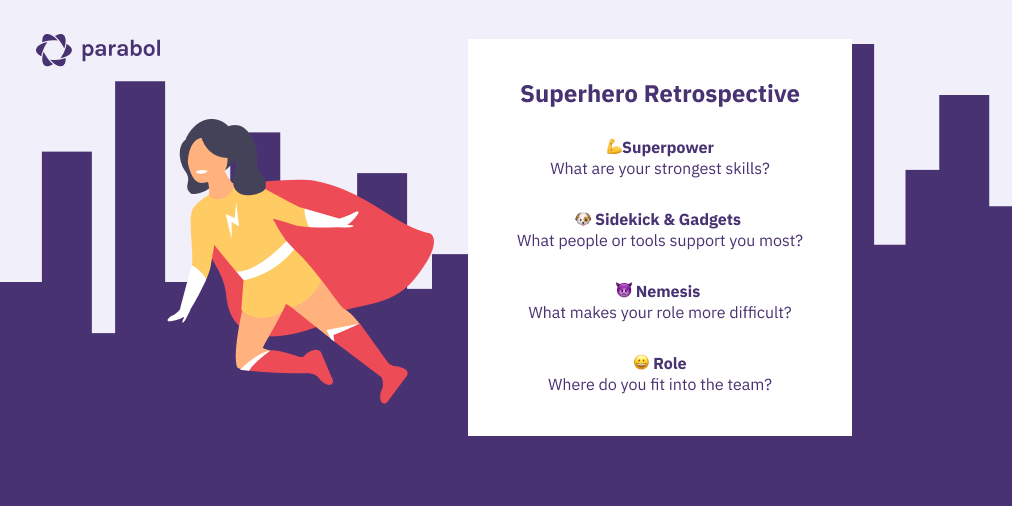
Even if team members have some casual familiarity with one another from the past, their relationships change when they become team-mates. The Super Hero retrospective helps team members learn how others perceive their roles and how they fit into the team.
A standard retrospective format for building team dynamics is the basketball retrospective, where participants are asked what they shoot, assist, and pass on, as well as what position they play. The Super Hero retro follows a similar format:
- 💪 Superpower: What are your strongest skills? Team mates can share what they feel confident about and can provide to the team. As a team lead, this also gives you an opportunity to see if there’s a skillset or expertise that’s missing from the team.
I’m pretty good when it comes to database work
- 🐶 Sidekick & Gadgets: What people or tools support you most? Team mates can express appreciation for one another or for others’ competencies. They can also name-drop tools or mention hacks they use to make work better. This will build trust and camaraderie among new team members.
I like using video to share in-progress work, and love it when my teammates share GIFs and video so I can see what they’re working on
- 😈 Nemesis: What makes your role more difficult? Like in a premortem, this gives you the opportunity to pre-empt issues that may arise, like team members being assigned tasks they particularly don’t like or not implementing a process that’s important to someone.
I really struggle with people adding tasks to my board without letting me know first. Just send me a quick note so I know something’s there and I have a chance to discuss it.
- 😄 Role: Where do you fit into the team? Finally, team members can share more about who they want to be within the new team. This tells you, as the lead, how they see themselves, and what kinds of challenges or opportunities they might be interested in.
I’m like Spiderman right now – I have a diverse skill set so I can hop between multiple different areas and work on a bunch of different things.
With a Super Hero Retrospective, your team can meet one another in their new roles, and discuss how they’ll come together to form the Justice League.
#7. Baking Danish Retrospective
Think DAKI for teams binging cooking shows

When a new but experienced agile team comes together, the best thing to do may be to jump right in.
If there’s no burning need to address on the team, then all that’s left to do is start and have fun – and what better way than with baked goods.
Get your butter and jam ready because the Making Danish Retrospective is a fun and tasty spin on the classic DAKI retro:
- 🍋 Drop: What ingredient do you want to leave out? Team members can share behaviors from previous teams that they want to drop. This helps the team start off with a clean slate – leaving the past behind and embracing the future.
In my previous team, team members could ask for a PR review at any point, and we expected 24-hour turn around. That made it hard to plan my work – I’d like to avoid that.
- 🍓 Add: What do you want more of? Coworkers can share anecdotes of experiences they want to see more of, habits they want to build, or goals they’re looking forward to achieving. This prompt helps the team build a team they feel proud of.
I’d love to do more pair work figuring out how we will build tricky features. It gives everyone confidence that we’re on the right track.
- 😋 Keep: What’s just right? This prompt encourages gratitude. The team can reflect on what is working well, so you don’t accidentally throw out something that’s valuable.
Open communication in public channels really helps me understand what everyone’s working on.
- 🍫 Improve: What ingredient should be higher-quality? Here, team members can speak to their values – what they care about and want to maintain well.
It’s important that we don’t lose track of our technical debt. I feel like we need to keep the whole product high quality, not just focus on shipping new features.
For teams that are pretty much ready to go off to the races, the DAKI-inspired Making Danish Retrospective brings together many of the elements in other formats. It lets teams talk about their values, share their experiences from other teams in the organization, express gratitude and also start looking forward, all with a delicious buttery crust.
Find The Right Retrospective Template For Your New Team
When new agile teams come together, they’re faced with a few headwinds:
- Team members may not know each other, and might need time to build trust
- The team doesn’t have established practices, and needs time to get these set up
- Teams might be nervous and uncertain about their role and where they fit in the new team
With the right retrospective template, the new team can have the important conversations they need to in order to go from forming to performing.
The right retro can solve all kinds of challenges for new teams, including:
- Managing the uncertain around the shift to a new team
- Helping team members get to know each other
- Building psychological safety
- Pre-empting problems
- Implementing learnings from previous teams
- Letting team members find their unique value
- Starting to build the teams’ unique agile rhythm
And so much more.
Whatever template you chose, hopefully it supports your team in having the conversation they need to have to set the right pace for success.
